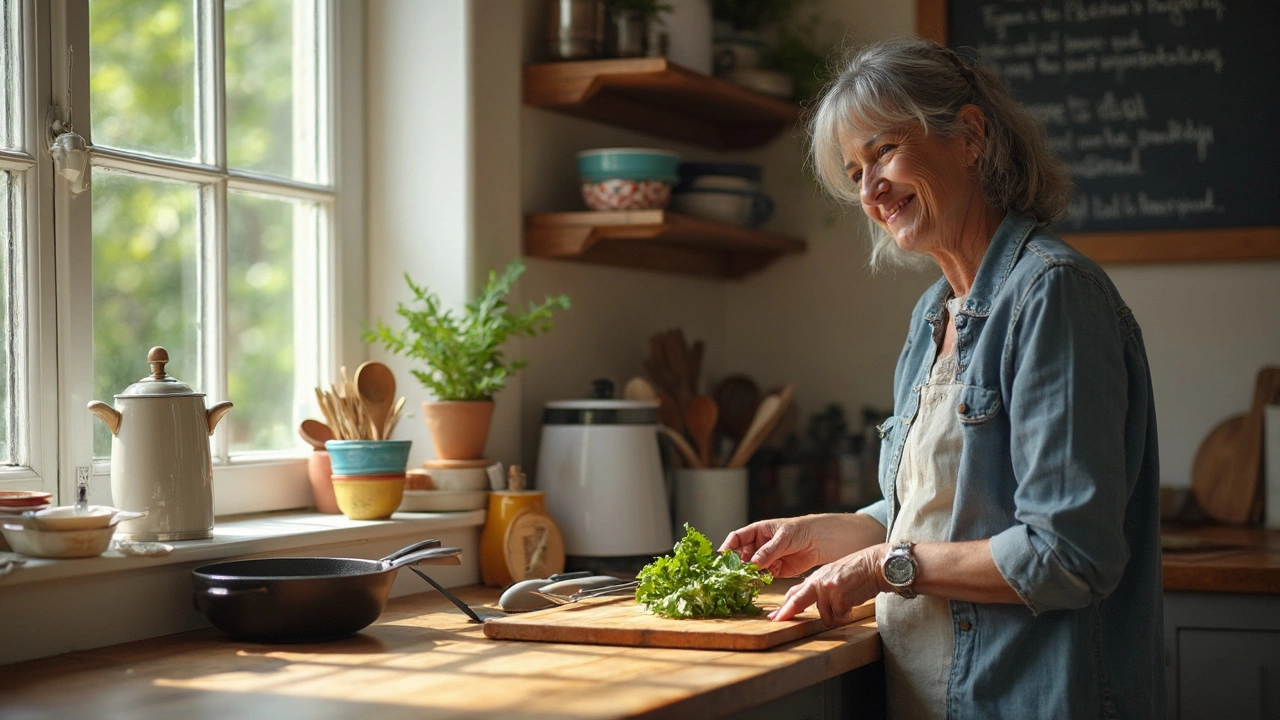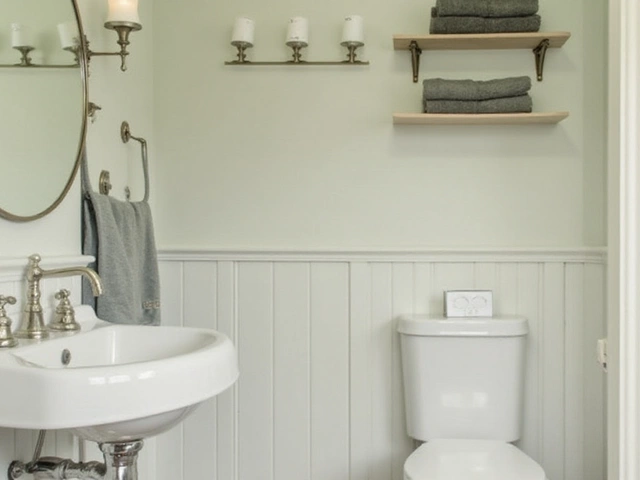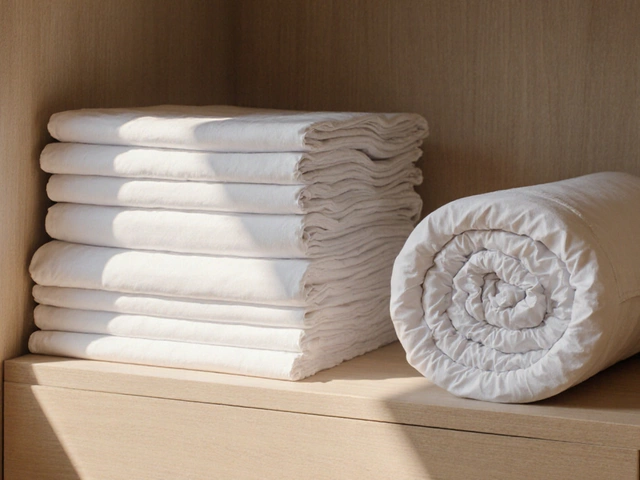Ever stopped to wonder what really counts as kitchenware? It’s more than just what you cook with—think beyond frying pans and spatulas. Kitchenware is everything you use in your kitchen to prep, cook, bake, serve, and store food. If it’s in your cabinets and you grab it while making dinner, that's kitchenware. It’s a wider club than most people imagine.
Getting clear on what kitchenware covers helps you organize your kitchen, shop smarter, and avoid falling for pointless gadgets. Not all kitchen tools are created equal, so knowing what you need (and what you really don’t) saves cash and space. If you’ve ever panicked about needing a zoodle maker or five different measuring cups, you’re about to find a much simpler approach.
- What Exactly is Kitchenware?
- Different Types of Kitchenware
- What Should You Actually Own?
- Smart Tips for Using and Caring for Kitchenware
- Fun Facts and Kitchenware Myths
What Exactly is Kitchenware?
Kitchenware sounds pretty straightforward, but it actually covers a lot. It’s the catch-all term for anything you use to make, serve, or store food in the kitchen. This isn’t just the stuff you pop on the stove—it includes all the basics, gear for baking, prep tools, serving items, and even storage containers. If you’re wondering if something counts, the answer is probably yes if you use it regularly for food.
You can break kitchenware into a few main categories:
- Cookware – Pots, pans, Dutch ovens, skillets. If it goes on a stove or in the oven, it’s cookware.
- Utensils – Spoons, spatulas, tongs, peelers. Basically, tools you use with your hands while cooking.
- Bakeware – Cookie sheets, muffin tins, bread pans, roasting trays. Everything baking-related lives here.
- Serveware – Bowls, platters, gravy boats. If it helps get food to the table, it’s serveware.
- Storage Containers – Those glass or plastic tubs that hold your leftovers.
No need to overthink it—if you pull it out to cook, mix, serve, or keep food, you’ve found kitchenware. People usually think of the basics, but even a garlic press or salad spinner fits the definition. It’s not about fancy gadgets, just practical stuff you grab all the time.
Here’s a quick look at what the typical household has, based on a 2023 survey from a popular kitchen retailer:
| Type of Kitchenware | Average Pieces per Kitchen |
|---|---|
| Cookware (pots, pans, etc.) | 8 |
| Utensils | 15 |
| Bakeware | 5 |
| Serveware | 6 |
| Storage Containers | 12 |
The numbers may sound like a lot, but when you consider things like spatulas, wooden spoons, or baking trays, it adds up fast. The key is this: kitchenware is anything that makes life easier in the kitchen and helps you get food on the table.
Different Types of Kitchenware
If you love food or even just eat it every day, your kitchen is probably packed with all sorts of gear. But kitchenware branches into clear groups, each with its own job. Knowing which main types exist keeps you from getting lost in a sea of silicon and steel.
- Cookware: This is your MVP. Think of pots, pans, skillets, stockpots, and woks. If you heat food on the stove or in the oven, you're using cookware. A nonstick pan gets tossed in most kitchens, but don’t sleep on a basic stainless-steel pot—you’ll use it for boiling, braising, even making popcorn. Fun fact: the average American household has six pieces of cookware.
- Utensils: These are everything you use to stir, flip, slice, whisk, or scoop. Big names here are spatulas, tongs, ladles, peelers, and whisks. You’ll see both handheld helpers (like a garlic press) and bigger basics (like a sturdy chef’s knife). If you want to chop veggies easily, a sharp knife and a solid cutting board beat any fancy gadget.
- Bakeware: Got a sweet tooth or love homemade bread? Then your kitchenware drawer better have bakeware like cake pans, muffin tins, pie plates, and cookie sheets. Silicone mats count too—they make clean-up a breeze. Glass vs. metal pans? Glass heats slower but keeps things hotter after you pull it from the oven.
- Serveware: Think serving bowls, platters, salad tongs, gravy boats, and even bread baskets. These pieces don’t do the actual cooking, but they make dinner look good and keep things practical.
- Storage: Leftovers have to go somewhere, right? Storage kitchenware includes glass jars, plastic containers, bag clips, and even beeswax wraps. Airtight containers help cut food waste—about 40% of food in the US goes uneaten every year. A tight lid can make more of a difference than you think.
Still wondering how these types break down in real life? Check out this overview:
| Type | Examples | Main Use |
|---|---|---|
| Cookware | Pots, pans, woks, Dutch ovens | Heating and cooking food |
| Utensils | Knives, spatulas, tongs, whisks, peelers | Prepping and handling food |
| Bakeware | Cake pans, muffin tins, baking sheets, loaf pans | Baking sweets and bread |
| Serveware | Serving bowls, platters, gravy boats | Serving and presenting food |
| Storage | Food containers, glass jars, wraps | Storing leftovers, keeping food fresh |
If you’re setting up a kitchen from scratch, just focus on the essentials from each group. You don’t need everything in every color, but you’ll want a basic lineup from each type of kitchenware.
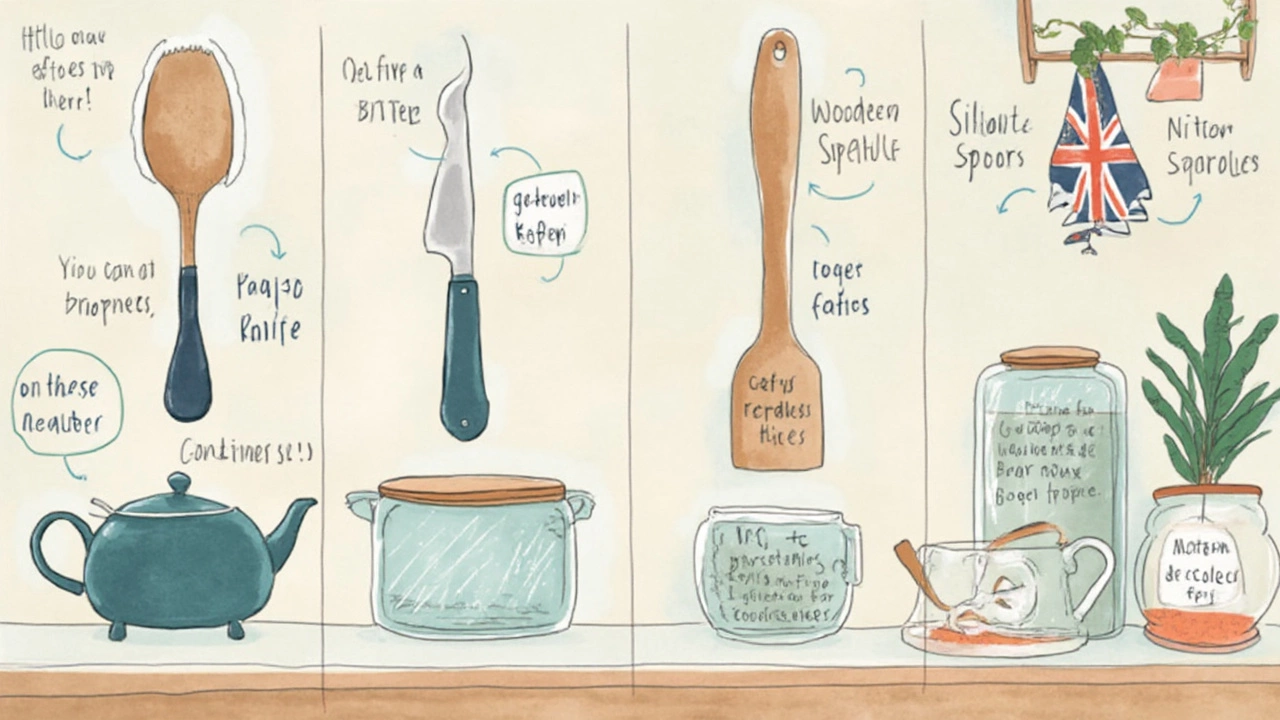
What Should You Actually Own?
If you’ve ever felt lost in a kitchen aisle, you’re not alone. Stores are packed with countless tools, but honestly, you don’t need most of them. Focus on the basics you’ll use every day. Here’s a breakdown of kitchenware you’ll actually reach for all the time.
- Cookware: Start with one good nonstick skillet, a sturdy saucepan, and a larger pot for boiling pasta or making soup. Stainless steel and cast iron are long-lasting choices if you want something that survives years of use.
- Utensils: Don’t overthink this. Have a solid spatula, a big wooden spoon, a slotted spoon, a pair of tongs, and a ladle. Throw in a whisk if you like to bake. Silicone options work for hot and cold foods and won’t scratch your pans.
- Knives: One sharp chef’s knife does most of the heavy lifting. Add a paring knife for fruits and smaller jobs, and a serrated bread knife if you eat a lot of bread or tomatoes. You don’t need a giant block—just these three cover almost everything.
- Cutting Boards: At least two—one for veggies, one for meat. This keeps things safe and prevents cross-contamination. Plastic boards are dishwasher-friendly, but wood feels sturdy and looks nice.
- Measuring Cups and Spoons: Essential for baking or when you want your recipes to turn out right every time. Stainless steel or sturdy plastic sets last longer than the flimsy ones.
- Mixing Bowls: Get a set of at least three—small, medium, and large. Stainless steel or glass are easy to clean and won’t hang onto odors.
- Bakeware: A sheet pan, a baking dish (something like 9x13 inch), and a muffin tin can cover everything from cookies to casseroles. You can always add more if you start baking more often.
- Storage Containers: Leftovers aren’t going to store themselves. Glass or BPA-free plastic containers with tight lids let you keep food fresh and organized. It’s smart to get a matching set so everything stacks neatly.
Sneaky tip: You really only need a few specialty gadgets (think can opener, peeler, or microplane). Don’t buy stuff you’ll use once a year. This approach saves money, keeps your drawers from overflowing, and makes it way easier to keep track of what you have. The most important thing when picking kitchenware is thinking about your own cooking style. If you barely bake, skip all the cake decorating tools. Love making soups? Invest in a quality stockpot instead of more gadgets. Build around what you actually eat and prep most often.
Smart Tips for Using and Caring for Kitchenware
If you use your kitchenware the right way and keep it in good shape, it'll last longer and help you cook better. You don’t need fancy tricks—just a few easy habits make a huge difference. The most important thing? Know what each piece is made of, and treat it accordingly. Different materials have different needs.
- Kitchenware made from stainless steel can go in the dishwasher, but hand-washing keeps it shiny and reduces scratches.
- Never use metal tools in nonstick pans; you’ll chip the coating and ruin the surface. Use wood or silicone instead.
- For cast iron, skip the soap—just rinse, dry completely, and rub with a little oil to keep it seasoned. If it does get a little rusty, scrub with coarse salt and some oil, then wipe clean.
- Don’t store knives loose in a drawer; use a block, a magnetic strip, or blade covers. Sharp blades aren’t scary—they’re safer because they cut better and slip less.
- Plastic containers stain easily with things like tomato sauce. A quick tip: Give them a rinse with a little baking soda and water, then let them dry in the sun to help fade stains.
You’ll want to declutter now and then. If you haven’t used that spiralizer since 2018, it’s just eating up drawer space.
Curious how long different kitchenware actually lasts? Check this table—most people toss things way earlier than needed:
| Type | Average Lifespan | Key Care Tip |
|---|---|---|
| Nonstick Pan | 3-5 years | Wash gently, never use metal utensils |
| Cast Iron Skillet | Indefinite, if seasoned | Dry completely, oil after use |
| Stainless Steel Pot | 10-15 years | Hand-wash when possible |
| Chef's Knife | Lifetime (with sharpening) | Store protected, sharpen often |
| Plastic Container | 1-5 years | Avoid the microwave for staining sauces |
One last thing: don’t feel like you need every gadget. Choose quality over quantity. A sharp knife, sturdy pan, and a couple of spatulas will take you further than twenty rarely-used tools. Take care of your everyday pieces—the rest just adds clutter.
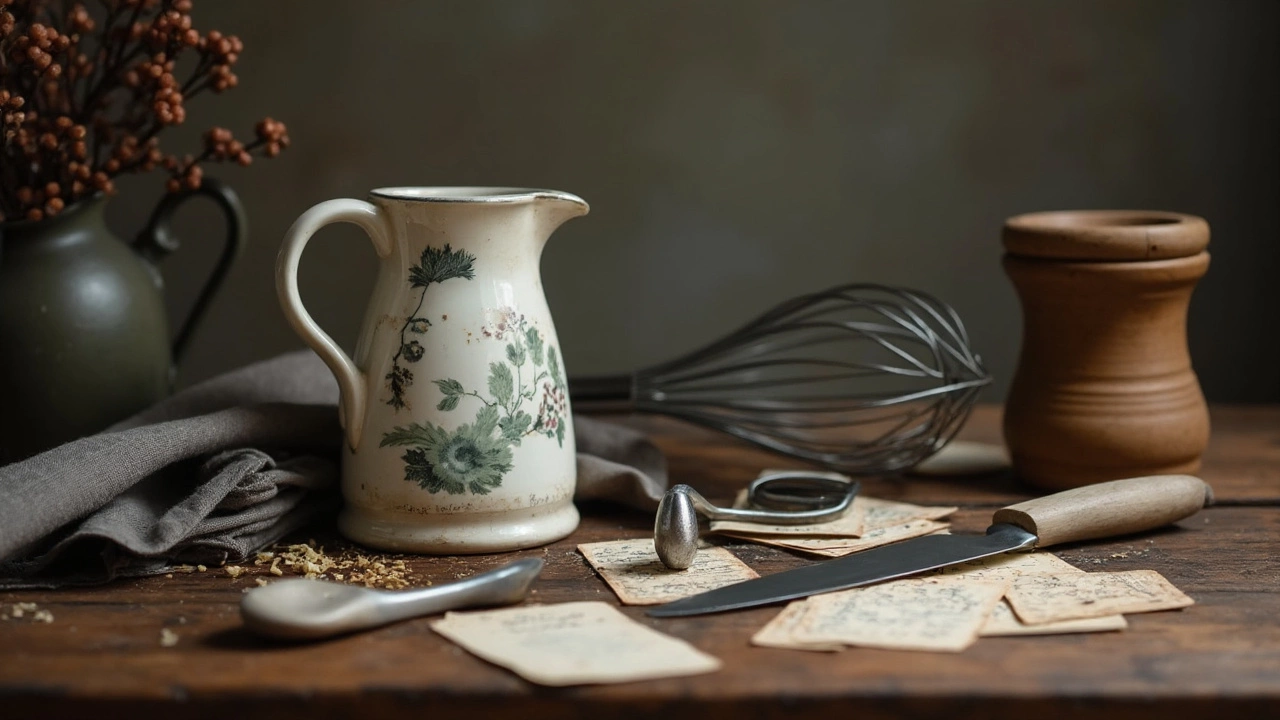
Fun Facts and Kitchenware Myths
Kitchen gear comes with a ton of weird history and some pretty stubborn myths. For starters, did you know the classic wooden spoon actually showed up in kitchens almost two thousand years ago? Ancient Romans used them to stir and scoop because wood didn’t react with their pots, unlike early metal spoons that rusted. And here’s something that still throws people off: a whisk didn’t get its balloon shape until the 19th century, and it changed everything for making whipped cream at home.
Let’s clear up some kitchenware myths that just won’t die:
- Kitchenware has to be expensive to be good. Nope! Many pro chefs swear by affordable brands or even second-hand finds, especially for things like sheet pans and spatulas.
- You need a giant set of gadgets. Actually, most everyday cooking gets done with about five items: chef’s knife, cutting board, skillet, saucepan, and a spoon. Those drawer organizers filled with single-use tools are usually just collecting dust.
- Nonstick pans are dangerous. Good news—most modern brands ditched harmful chemicals years ago. If your pan is made after 2015, you’re likely in the clear on that PTFE and PFOA drama.
- Cast iron is hard to care for. Honestly, you can clean one with just hot water and a towel. Oil it lightly to keep it slick, and that’s about it. Lots of people stress for no reason.
Check out these quick facts to surprise your friends (or win at trivia night):
| Kitchenware Fact | Surprising Detail |
|---|---|
| The potato peeler | Invented in Switzerland in 1947, and it hasn’t changed much since. |
| Spatula name | Comes from Latin for “flat piece”—the ancient word was "spatha." |
| Most stolen kitchen item | Apparently, “fancy” forks from restaurants. That’s why they’re almost always mismatched in diners. |
| Measuring cups | First mass-produced in Boston in 1896 for home bakers. |
| Largest skillet | Weighs over 14,000 pounds. It’s in Pennsylvania and big enough to fry 365 chickens at once! |
One last myth: all plastic containers are bad for microwaves. That’s not true—if the packaging says “microwave-safe,” you’re good. Still, glass or ceramic can last longer and doesn’t stain from tomato sauce disasters (we’ve all been there).

